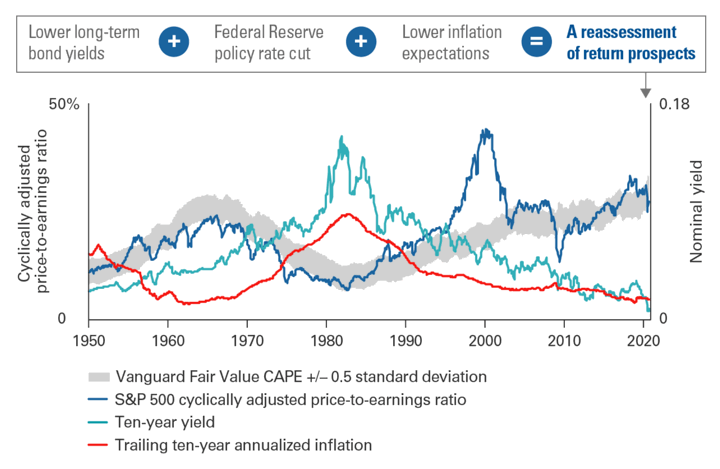A lot of investment “analysis” is simply finding a reasonable and convincing way to explain present market prices. Whatever the price is, you can find a story to match. Working backwards like that means there usually isn’t much useful nor actionable information. I say this before I link to the recent Vanguard article Why equity markets have recovered, mainly for this chart of what they see as a “fair value” for CAPE (cyclically-adjusted PE) or PE10 (price/average earnings over last 10 years):

Vanguard’s U.S. fair value CAPE framework is based on a statistical model that corrects measures of cyclically adjusted price-to-earnings ratios for the level of inflation expectations and for interest rates. The statistical model specification is a three-variable vector error correction including equity-earnings yields, ten-year trailing inflation, and ten-year U.S. Treasury yields.
Basically, low interest rates (with low inflation) mean that stock earnings are more attractive and thus result in higher price/earnings (PE) ratios. The rest is the usual hedging and disclaimers. “The market could go up or down from here.”
Rates are not just “low”, they are the lowest in history. The real yield on 30-year TIPS (inflation-linked Treasury bonds) are negative for the first time in history – so low that people are willing to hand over $116 today in order to get only $100 back (adjusted for inflation) after 30 years! If bonds are the most expensive in history, does that mean the stock market should be the most expensive in history? The S&P 500 did just hit an all-time high amidst enormous economic suffering for much of the working population. This chart tries to make sense of things, but still I don’t like the idea of calling the current state of things “rational”.
 The Best Credit Card Bonus Offers – 2025
The Best Credit Card Bonus Offers – 2025 Big List of Free Stocks from Brokerage Apps
Big List of Free Stocks from Brokerage Apps Best Interest Rates on Cash - 2025
Best Interest Rates on Cash - 2025 Free Credit Scores x 3 + Free Credit Monitoring
Free Credit Scores x 3 + Free Credit Monitoring Best No Fee 0% APR Balance Transfer Offers
Best No Fee 0% APR Balance Transfer Offers Little-Known Cellular Data Plans That Can Save Big Money
Little-Known Cellular Data Plans That Can Save Big Money How To Haggle Your Cable or Direct TV Bill
How To Haggle Your Cable or Direct TV Bill Big List of Free Consumer Data Reports (Credit, Rent, Work)
Big List of Free Consumer Data Reports (Credit, Rent, Work)
A couple things come to mind when I look at this. The first and most important question is, how do we have record debt, record low yields, and little inflation? That’s really the question of our time.
The second thing is that going forward stocks should not be a good investment. If rates were to rise, we would have lower corporate profits which would lower stock prices, but we would also have P/E contraction. A double blow.
Things I am reading elsewhere are very much arguing that we are in for a bout of increased inflation in the medium term. While I personally don’t think we are in for 80’s era inflation (yet), inflation protected assets certainly have some added value at the moment. While some stocks do have inflation protection, others don’t (wait until you read about a Kellogg’s suffering increased commodity prices but being unable to pass the entirety of those prices along to consumers) – real estate and commodities make sense in a ‘more inflation’ environment.
We have had inflation in some things, particularly real estate and stocks. These are not included in CPI inflation though. Many of The things in CPI, consumer durables and nondurables, are vulnerable to other factors besides just the monetary base. Automation, globalization, union busting/ cheaper labor have been decreasing the price of these things for decades, even without inflation adjustments
I think you are right. Prices rise but somehow its only asset prices and commodities. Wages are kept low by immigration, outsourcing, and automation so the price of TVs and soybeans don’t go up. At the same time, real estate, stocks, and bonds explode in price.
Does anyone know where you can view this chart or just Vanguard’s fair value CAPE on an ongoing basis?
Interested in knowing this as well. If anyone knows a way to follow this Vanguard CAPE or any other metric that ajust to inflation and interest rate, pls comment. Thanks